ARTWORKS 2025

TRAFFICART

FINE ART & SCULPTURE
Will Ryman
Britt Boutros-Ghali
Moyosore Martins
Miranda Pissarides
Christopher Winter
Paulo Laport
Jon Merz
Gregory De La Haba
Michael Campbell
PHOTOGRAPHY
Formento & Formento
Yasmine Chatila
Torkil Gudnason
WILL RYMAN b. 1969)
Untitled, 2011
(Rose 50 with lady Bug and Cigarette)
Steel, epoxy resin, plaster and paint
67 x 52 x 56 in. (170 x 132 x 142 cm)
Price upon request
Provenance:
The artist
Lio Malca Fine Art, New York
Private Collection
Christie’s New York: First Open, Friday, March 08, 2013, Lot 190
Edelman Arts, New York

BRITT BOUTROS-GHALI, a world-class artist, whose works from the 1950s forward have reflected the traditions of abstract expressionist and color field painting. Britt follows in the tradition of pioneers such as Helen Frankenthaler and Joan Mitchell, bringing a unique energy to her dynamic, large-scale paintings. Born in Norway in 1937, Britt’s is deeply influenced by the dramatic light of her homeland and her formative experiences during World War II. For over five decades, she has lived and worked in Egypt, drawing inspiration from its rich culture and history. Her powerful works embody the spirit of action painting, balancing structure with spontaneity.
From her studios in Cairo and Agami, Britt creates vibrant, expressive works, while her home serves as a gathering place for artists and collectors alike. Since 1962, her work has been exhibited worldwide and is held in prestigious collections. She has been honored with Norway’s Order of St. Olav and Egypt’s 2023 Lifetime Achievement Award for Women in the Arts—recognition of her profound impact on contemporary painting. The demand for her work is more fervent than ever as she continues to break boundaries and capture the hearts of art enthusiasts and collectors worldwide.
WEBSITE LINK


BRITT BOUTROS-GHALI (1937)
Untitled, 2024 (No 106-024)
on canvas
190 x 135 cm (75 x 53 in.)
Following page:
Untitled, 2024 (No 106-024)
on canvas
190 x 135 cm (75 x 53 in.)
Untitled, 2024 (No 106-024)
on canvas
190 x 135 cm (75 x 53 in.)









MÓYÒSÓRÉ MARTINS is a New York-based Nigerian contemporary artist taking the art world by storm. He’s a renaissance man who dabbles in graphics, product design, and music. MOYO’s paintings are deeply narrative and relate to his personal journey. He embodies his traditional Afro-cultural, spiritual roots and fashion-forward sense of aesthetics.
Born of Brazilian descent with both parents from Ekiti state, Nigeria, MOYO developed a sense of mixed cultural independence from his family’s tribal roots and developed his artistic vision from his travels and upbringing. Inspired by the streets of London and New York, his college years in Ghana and Ivory Coast blend into his artwork while expressing his Yoruban cultural roots.
MOYO is self-taught and is influenced by his internal vision and spirituality.
WEBSITE LINK
“Móyòsóré Martins embodies a rare and precious figure of the visual artist: the one making art as a vital necessity, and not a bohemian pastime. From Nigeria to Bronx, New York, where I met him. Móyòsóré’s paintings speak to us about the true way of the world: a world and an art made of migration, crossing the boundaries to exist, mixing cultures to invent a new one.
Jerome Neutres, Curator (Past Director of the Réunion des Musées Nationaux- Grand Palais in Paris and President of the Musée du Luxembourg)
The artist in his Bronx, NY studio, 2025
Photo: Daniella Liquori © 2025



Móyòsóré Martins exhalts the tradition of the Abstract Expressionist painters—the beginning. Figurative and conceptualist elements then take the stage. Hatching, hard-handed distress brings the work together in harmony and depth—Móyòsóré’s own total.
— Asher Edelman
The Watchman is a character that follows Moyosore Martins throughout his artistic journey. In African culture, the watchman is oft depicted as a sculpture of a seated figure who observes, protects, and learns—an archetype deeply rooted in the Yoruba tradition and symbolism. For Martins, this character is more than just a cultural motif; it is a recurring theme and a central figure that weaves through the narrative of his work. The watchman is ever evolving , serving as both a literal and metaphorical representation of his personal growth and perspective, as well as it’s representation in his work.
When Martins first left Africa, arriving in New York, with few resources. He found work as a night watchman in the Bronx—a role that tied his life experience to the watchman character. Over time, as his work has evolved, the watchman has been reinterpreted and transformed, reflecting Martins’ changing understanding of himself, his art, and his role as an observer, protector, and chronicler of life’s truths. This enduring theme underscores his connection to his African heritage while highlighting his ability to adapt and reinterpret traditional symbols in a contemporary context.
MÓYÒSÓRÉ MARTINS
In the time of Place, 2023 Oil, oil stick, pigments, graphite on canvas 100 x 82 in. (250 x 205 cm)




Mixed media on plexiglass
(Oil, oil stick, pigments, ink, graphite, and collage)
Painted on both sides
132.1 x 127 cm (52 x 50 in.)




Foreseeing, 2023
MÓYÒSÓRÉ MARTINS, 1986
TABLET II A and B, 2023
Oil paint, oil stick, pigment, pastel, and acrylic on canvas, mounted on board
2 X 24 x 18 in. (60 x 45 cm)


GREGORY DE LA HABA is an American interdisciplinary artist, writer, curator, and cultural producer. Born and raised in New York City, he seamlessly integrates fine art and street culture with a foundation in traditional artistic research. A skilled painter with a pedagogical lineage that stretches back to Jacques-Louis David, de la Haba is an exemplary practitioner of fine art whose conceptual practice resists categorization. His work explores themes of addiction, masculinity, and ‘Duende’, a heightened state of emotion, expression, and authenticity derived from pure artistic expression. Through this lens, he unlocks his true self in art and life.
His creative journey is profoundly influenced by his life in a city he describes as an enduring source of inspiration. His work exudes a remarkable energy and depth of color, drawing from the legacy of celebrated masters such as Mark Rothko, whose influence has left an indelible mark on de la Haba’s approach to composition and emotional resonance. His chosen palette is often intense, dynamic, and, at times, unflinching in its boldness, evoking feelings of hope and vitality while simultaneously prompting viewers to reflect on optimism even in the face of uncertainty and disorder. Photography also plays a crucial role in his creative process. Drawing from his extensive archive, he integrates documentary-style photography into his canvases, using storied locations as backdrops that enrich his work with urban stories and social context. By mixing photography and painting, de la Haba creates compositions that reflect the energy and pulse of the city, merging the ephemeral nature of street life with the permanence of fine art.
Since 2008, de la Haba has produced art-related ventures through his creative platform Bodega de la Haba. Notable projects include hosting literary events with Pulitzer Prize-winning poet Franz Wright, curating a survey of significant works by the celebrated artist Judy Rifka at Pulpo Gallery in Murnau am Staffelsee in Germany, and producing and narrating Terrence Browne’s Irish art history musical “Hazel - Made In Belfast” which premiered at Carnegie Hall.
In 2009, de la Haba was the Artist-in-Residence at ‘Jack the Pelican Presents’, where he firmly cemented his notoriety with a provocative body of work.
In October 2024, de la Haba won the First Prize at the Durres International Biennale in Albania.
A cum laude graduate of Harvard University, de la Haba has written on a number of artists including Billy the Artist, Richie Culver, Marcus Jansen, Cristina BanBan, Oscar Murillo, Al Diaz, California Locos (Dave Tourjé, Chaz Bojórquez, John Van Hamersveld, Norton Wisdom and Gary Wong), Miya Ando, Andy Moses, Timothy Warren Williams, Lance De Los Reyes, Mel Bochner and many others. De la Haba’s writings and artworks have been featured in many publications including The New York Times, Southampton Review, Rizzoli’s Irish America, New York Arts Magazine, L’Officiel, and Portray.
De la Haba’s work has been exhibited internationally in numerous galleries and art shows.



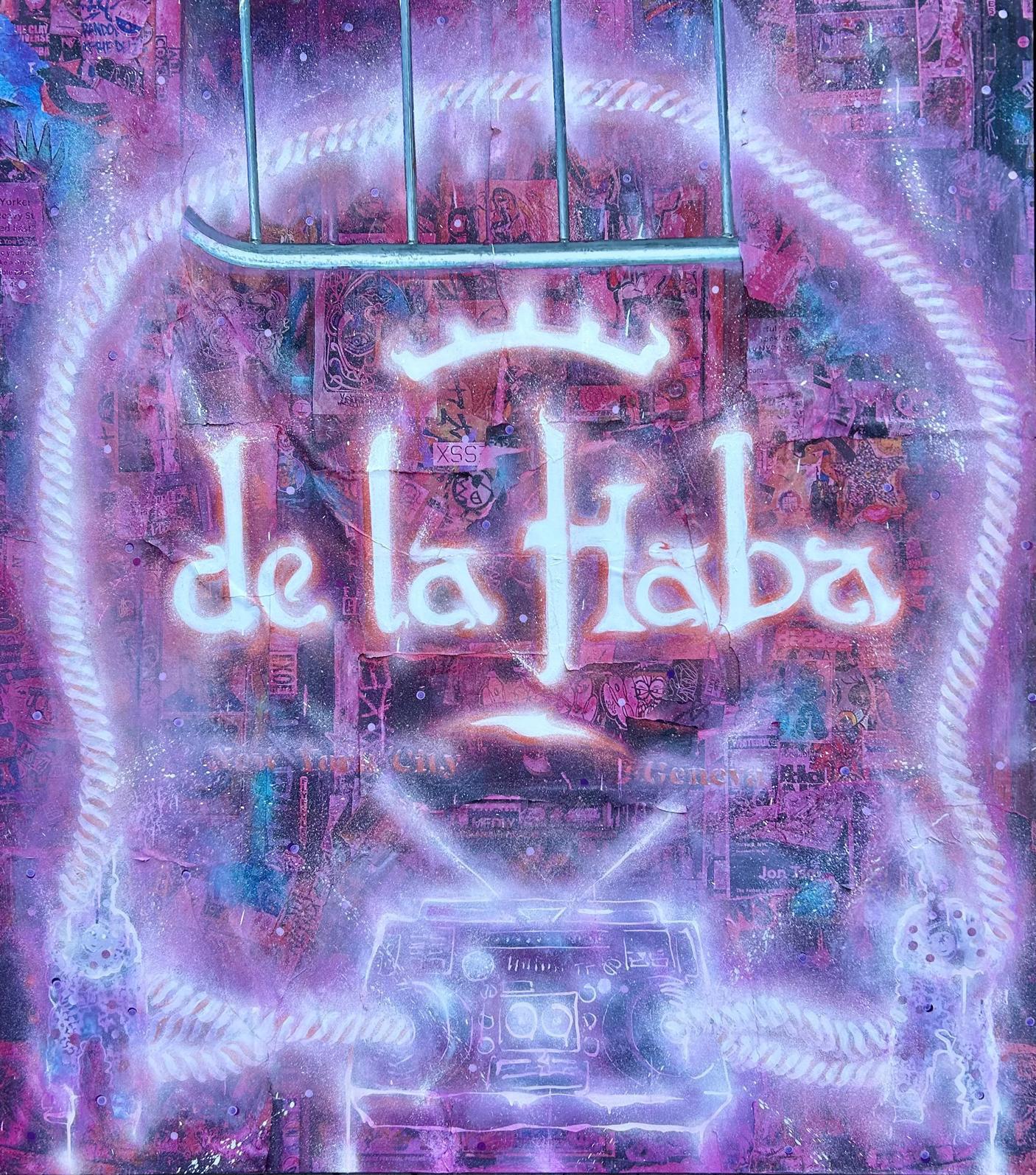

Miranda Pissarides is an independent London based artist with Cypritic and Italian origins. Miranda’s artistic practice concentrates on the exploration of different forms and textures by applying all-encompassing mediums. Miranda works with raw pigments as a basis and transforms to a new unique color palette. She creates works fixated on dualities and the spaces in between them. She works in both the fields of painting and sculpture, with each practice informing the other-her paintings have the depth and weight of sculpture, while her sculptures have the ethereal and fluid qualities of painting. In the large-scale sculpture, entitled Melting Cake, 2024, Miranda used raw pigments to convey the conflicting feelings of desire and repulsion. The use of resin blended into this monumental stalagmite creates an effect of liminality, a substance that seems to exist between the states of solid and liquid.
A student of the Slade School of Fine Art, University College London, with Fine Art and Theory in 2012. Miranda’s artistic journey includes notable achievements such as the Art Achievement Award at Queen’s College London in 2007 and a Distinction grade during her Fine Art Foundation Diploma at St Martin’s College, London in 2008.
Miranda has exhibited extensively in the UK, New York, Brazil, Italy, Spain, Cyprus, and Japan. She has held solo exhibitions in Rome, Japan, and London, including a significant solo show we organized at Edelman Arts in New York City in 2020. Her work has also been displayed at prestigious venues like the Saatchi Gallery in London, where she won the Saatchi Gallery Young Artist Award in Fine Art in 2018. Notably, her sculptures were selected for exhibition at the Saatchi Gallery.
Upcoming exhibitions
Rome, October 2025, group exhibition, La Nuova Pesa Gallery
Venice, January-February 2026, group exhibition, Barbati Gallery
Mexico, January 2026, two person show, Taller Sangfer Gallery
Miranda in her London studio, 2025

39 1/2 x 39 in. (100 x 00 cm)

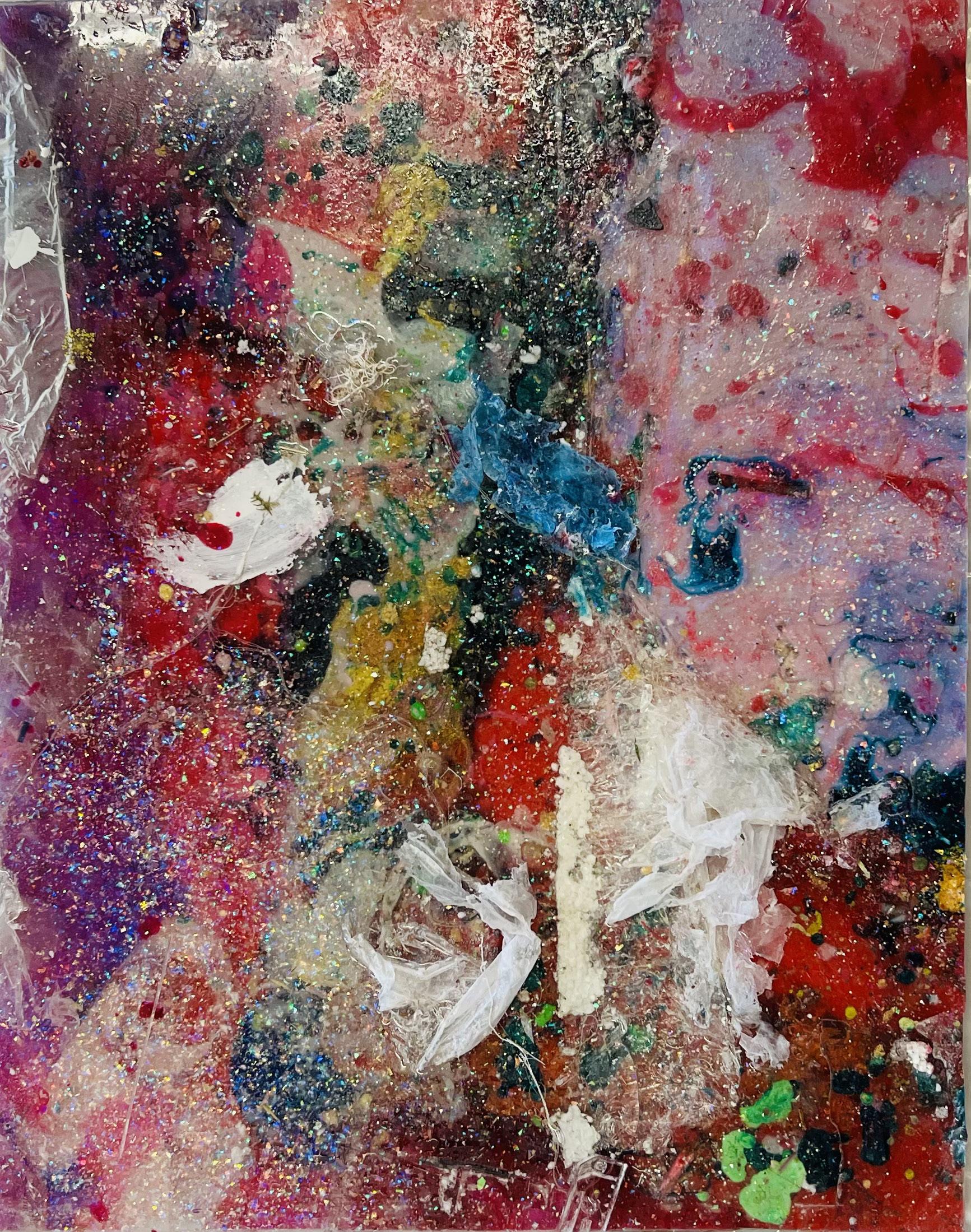


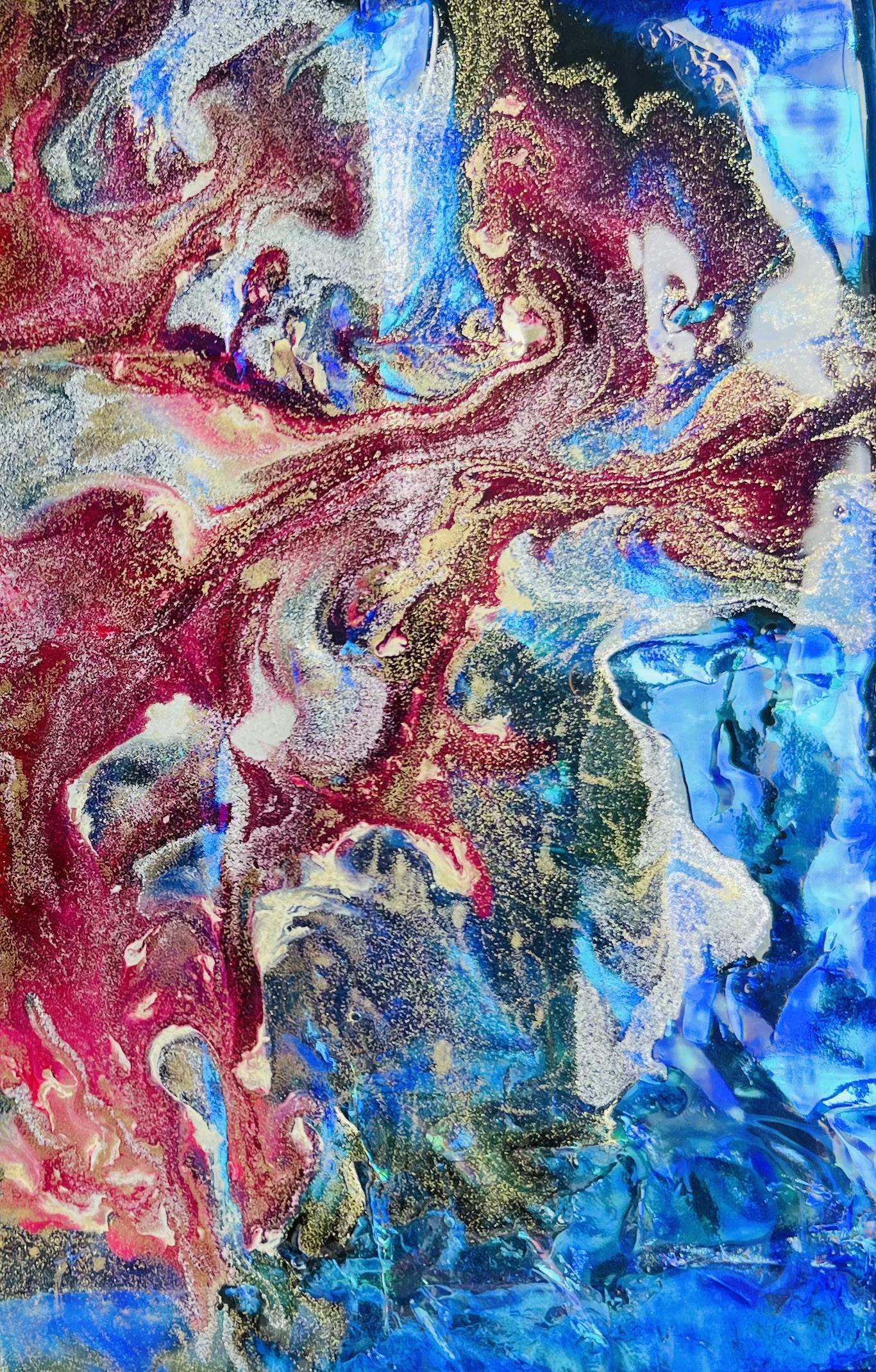
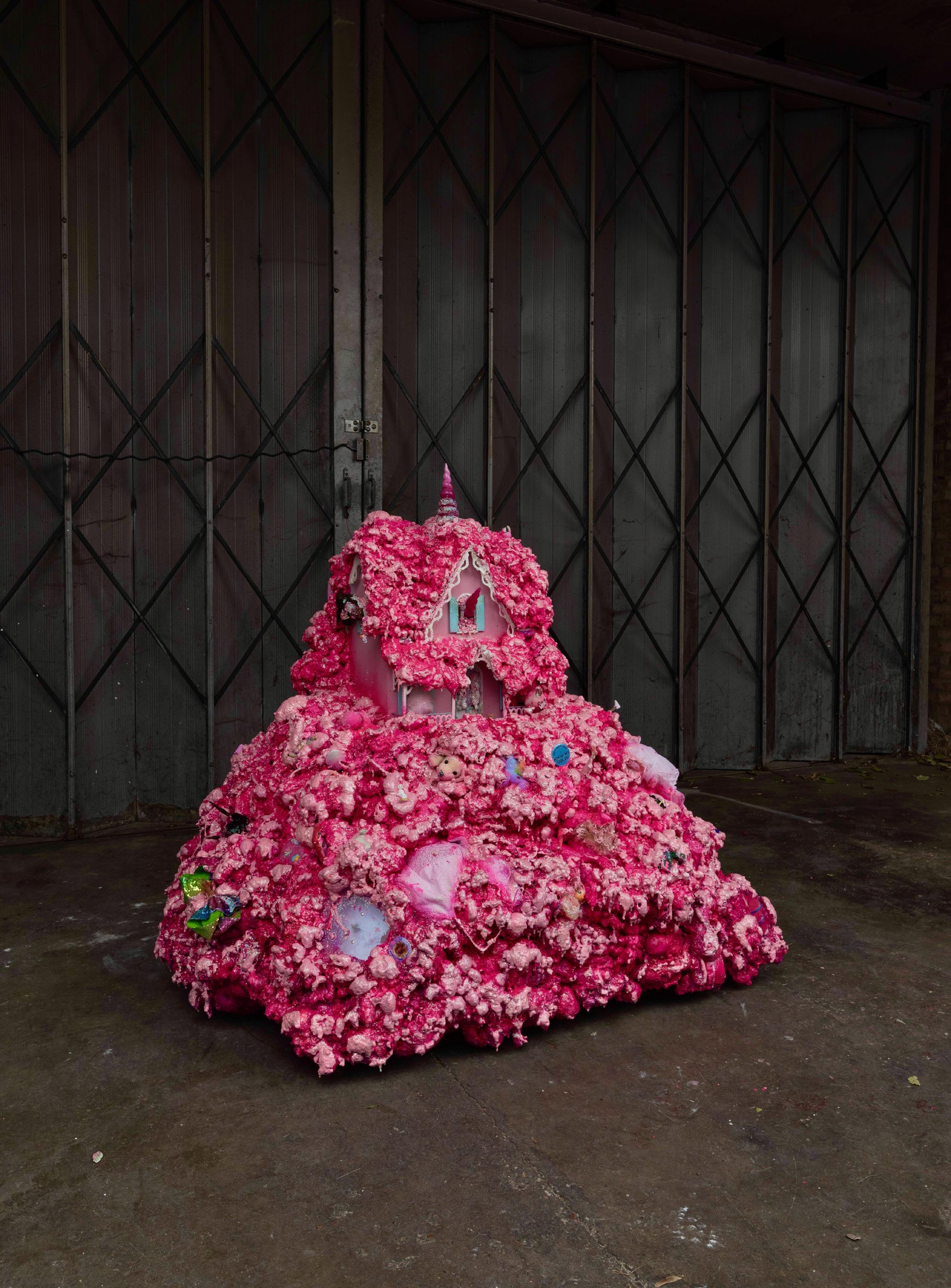



CHRISTOPHER WINTER (*1968) is a British painter and installation artist. He lives and works in Berlin and Hastings, UK. Primarily, literature, folklore and science influence his work. Winter’s vibrant paintings are mysterious yet often question the nature of our contemporary reality.
He studied at Camberwell School of Art (BA Fine Art) and under Professor Fritz Schwegler at Düsseldorf Art Academy. In October 2021 he had a solo exhibition “Archipelago of the Mind” in Berlin at ZAK – Center for Contemporary Art that has travelled to Museum Heylshof in Worms, Germany in June 2023. He also exhibited in “Other Worlds Than This” in June 2022 with Salvador Dali and Giorgio de Chirico at the Nassau County Museum, New York.
He has exhibited worldwide in museums and galleries. His work is in many private collections (including the Rothschild and Borghese families) and public collections which include AMMA Foundation, Mexico City; Berlinische Galerie Museum for Modern Art, Berlin; Wilhelm-Hack-Museum, Ludwigshafen, Germany and The Frances Lehman Loeb Art Center, New York, USA.
In 2015, Kerber Verlag published a large monograph of Winter’s work to mark 20 years of painting in Germany titled “Dizzyland. 20 Years in Germany”. In 2021, Kerber published a second monograph titled “Archipelago of the Mind” in conjunction with his exhibition at ZAK Center of Contemporary Art in Berlin.
Artist Statement
Through painting and drawing, both abstract and figurative, also through performances, installations and sculpture Christopher Winter reflects on his experience of contemporary reality. Often concepts drawn from folklore and fairy tales are woven together with science and philosophical threads, ultimately depicting narratives that are influenced by real and virtual worlds. In the series of works “Speculative Realism” Winter combined his figurative and abstract painting with installation, thus broadening his understanding of space and painting and extending his narratives beyond the canvas. Some series include passionate explorations of the primordial forest, the brutality of German fairytales and stories of innocence and experience. In his séance performances he “channels” the spirits of dead artists and produces their drawings – thus connecting to the possibility of “other” worlds. Quantum theories of our universe and the boundaries of human thought fascinate him and have resulted in installations like “Mirror World Space Collider” (2018) and paintings like “Space Time Reality” (2016).
His latest series “Super Nature” evokes the experiences of humans in the natural world. The paintings explore the pure reverie of personal encounters and the wonder of the untamed at first hand. Many of my paintings portray solitary figures in a kind of ecstasy, heightened by a connection to the wild. Acrylic paint is employed in a vibrant colour field technique in order to increase this intensity of feeling. The fragility of the environment and its constant changing character, the planet plummeting through space to its possible desecration by our own hands is an echo that he presents in the landscapes.
“I think painting should manifest life, celebrate it and be exuberant. When I work on a canvas I’m drawing on my own mysterious and strange experiences - things that hang at the periphery of my vision that are worthy of becoming art. They may be provocative or possess an uncanny resonance – offering up questions that leave the viewer wondering. What if…? Is one of my favourite questions.”

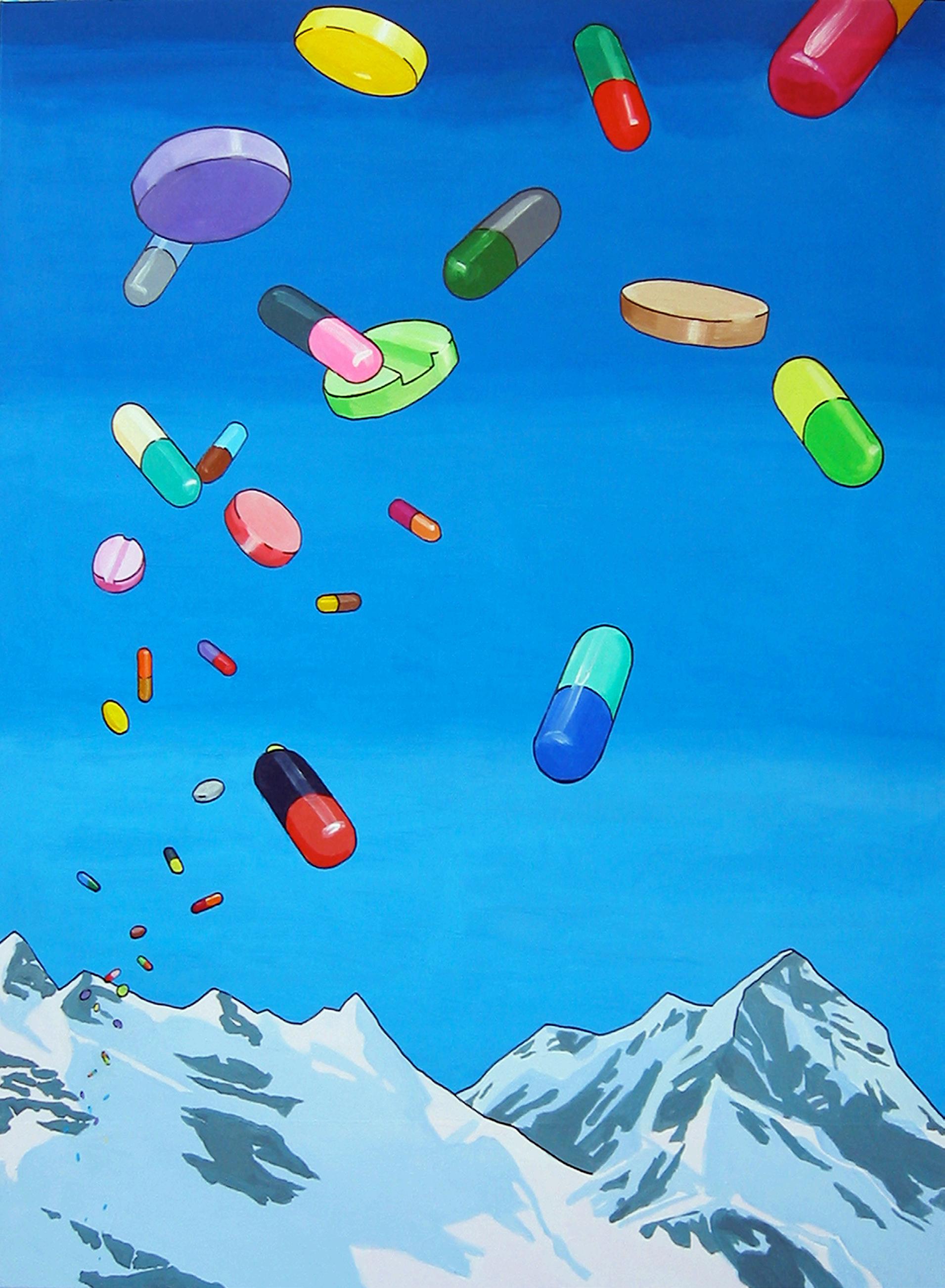

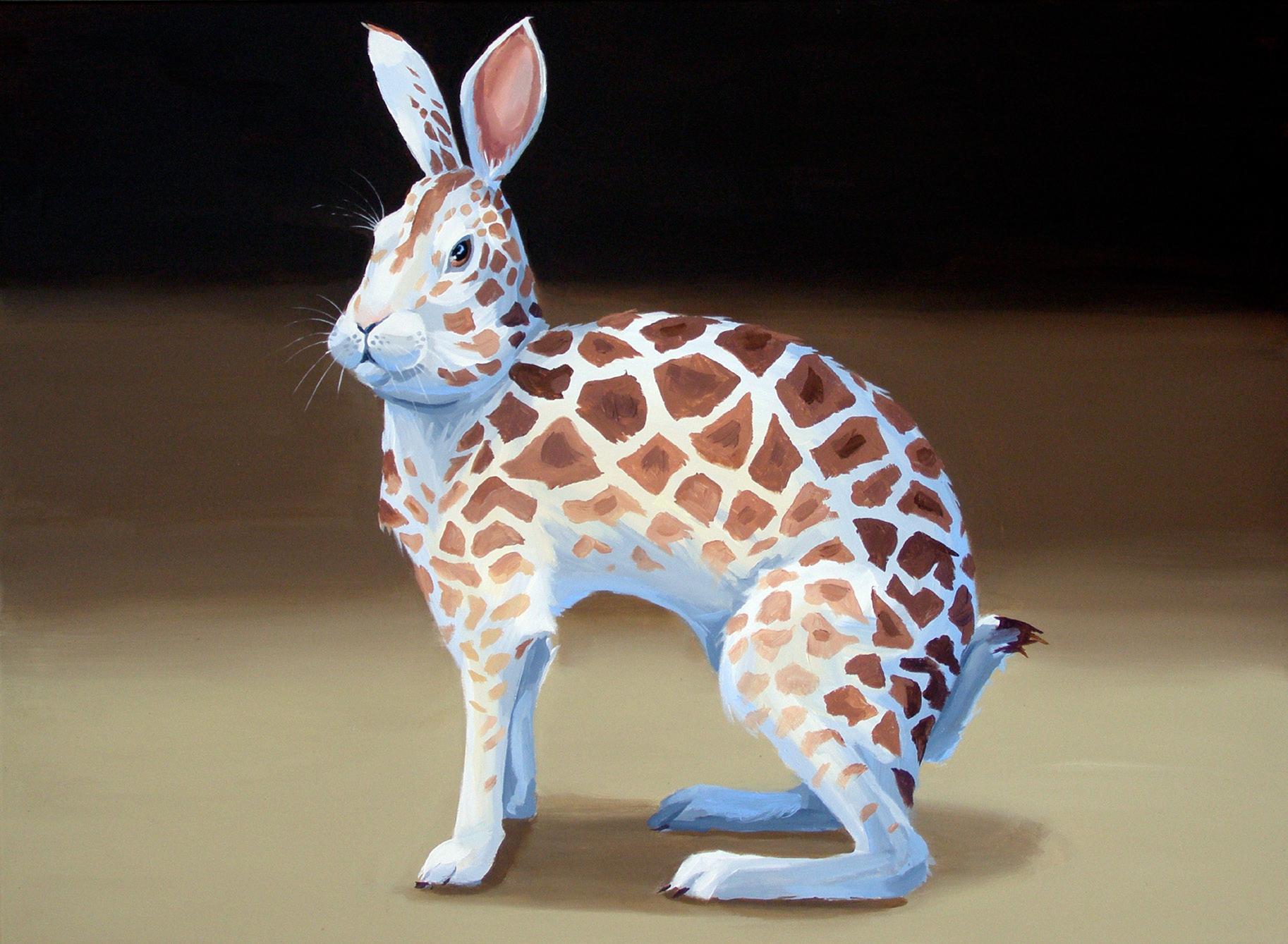






JON MERZ is a Swiss Postwar & Contemporary artist, born in 1981 in Neuchâtel.
Merz, who lives in Berlin and Basel, trained at the Bern University of the Arts and the Hamburg Academy of Fine Arts. He has been exhibiting his work in Switzerland and abroad over ten years.
He can almost be seen as a painter with an easel and a summer hat in the outdoors, almost as if he were a 19th-century Impressionist. However, the paintings depicted in his immediate surroundings resemble Expressionism and occasionally Symbolism. The works appear classically styled, almost in the manner of Old Masters, showing a strong art historical influence. Much of it feels somewhat familiar, yet at the same time, it is extremely surprising and refreshing, especially when one is aware of the artist’s earlier work, such as his monochrome-painted wooden cubes from the early 2010s or his constructions made from plywood boards, steel rods, and other materials from hardware stores. These early pieces, which fluctuate between paintings and early objects, evoke movements like Post-Minimalism and the Conceptual Art of the 1970s, as well as Hard Edge or Color Field painting. They also recall German artists like Joseph Beuy’s students Imi Knoebel and Blinky Palermo. Like them, Merz emerges as a new representative of constructivist, non-objective art – a kind of Constructivism 3.0.
His paintings are characterized by a masterful interplay of light, color, and texture, which invites a nuanced examination of both the physical and metaphysical realms, prompting viewers to embark on a journey of introspection. Merz often marries representational elements with abstract forms, blurring the boundaries between realism and abstraction. Furthermore, Merz’s technique demonstrates an acute awareness of composition and rhythm, integrating dynamic brushwork with meticulous detail.
The artist was nominated for the Swiss Art Awards 2024 and has benefited from several residencies.
Merz’s work has been exhibited in numerous galleries and art shows, and institutions, such as the Bern Cantonal Bank and the Musée d’Art et d’Histoire de Neuchâtel, have begun acquiring his paintings. His latest Zurich solor show at Pascal Robert Gallery was an exemplar example of his refreshing work, which garnered great success and good sales.

200 x 150 cm (78 3/4 x 59 in.)
(JDM.00016.M)


Sohn des Glücks, 2021 Oil on Belgian linen
40 x 50 x 2 cm (15 3/4 x 19 3/4 x 3/4 in.)
(JDM.00019.M)


FORMENTO AND FORMENTO come out of a hybrid lineage of art and fashion. You might call them Third Picture Generation artists. Their work conjures the sensibilities of an art film and extends it through lengthy series. Although their work is not explicit fashion, they tend to observe high fashion standards in casting, hair and makeup, which invariably injects a frisson of glamour into the scenario. Their locations and their light are first rate, giving a genuine cinematic sensibility to the photographs with big screen values, but Formento & Formento are a duo that travels light and manages to achieve soundstage quality without Hollywood budgets.
Richeille Formento a former graphics designer, styles and art directs the pictures while her husband BJ Formento lights and photographs. In their first major body of work they created a dramatic portrait of the American West, traveling in an 25 foot Airstream and finding locations and casting on the fly.
In their work there is no resolution, only an allure that inspires longing for something strange and unknown. Everywhere there are hints of what might link these images, but the movie only happens in your head and it can be different every time. Real life happens in motion like cinema. Dreams, bounded only by the imagination, begin in stills.
Formento and Formento have come a long way in a s short time, but they have shown that they live for the journey and it will continue, leading, wherever it takes them. They are professional travelers, bringing expertise imagination and almost an alien gift for absorbing and rendering the spirit of a time and place. William S Burrougns, who loved to collaborate and who created “the cut up method” with painter Brion Gysin, said that when two minds work together they create a third mind. Here we see that two eyes can create a third eye, and everyone knows that the third eye can see through time and space, showing us the things otherwise invisible.
—Glenn O’Brien
Formento & Formento are represented by several top galleries including Fahey Klein Gallery, Los Angeles; Taylor and Graham Gallery, New York City; Robert Klein Gallery, Boston; and ARTITLED contemporary UK and The Netherlands
FORMENTO + FORMENTO The Japan Diaries: Maaya XIV, Nishi-Sugamp, Japan 2013
Pigment Print 40 x 60 in (101.6 x 152.4 cm) Edition 3/7 + 2 AP



Japan Diaries (2013-present):
FORMENTO + FORMENTO
The Japan Diaries: Quorra XXV, Akasaka, Japan
2013
Archival digital print
60 x 40 in (101.6 x 152.4 cm)
Edition of 5/7 + 2 AP
In this series, F&F conjure 1950s Japanese cinema, the photographs of Nobuyoshi Araki, Ukiyo-e woodblock prints, and the erotic imagery of Ero Guro paintings. As outside observers, the Formentos’ stylized images explore the dichotomies that embody modern Japan, blurring the aesthetics between tradition and the ultra modern, fantasy and reality. The captivating tableaus exude a sense of tension,melancholy, and a quiet unease. Each image from Japan Diaries exists as if it were a still taken from a noir Japanese film, each solitary figure yearning for something unknown.

She Is Cuba (2014):
In Cuba’s forbidden allure, amongst the crumbling walls of colonial architecture, the abandoned cinemas and casinos, the street of old Havana and all the glory that once was, Formento + Formento created photographs where the radiant, bombastic Cuban woman plays the heroine. They have captured the twilight of the Castro era, the imminent change, the struggle, the anxiety and the hope.

Torkil Gudnason is one of the leading beauty, fashion and still life photographers of our time. The Danish-born, Brooklyn based photographer's commercial work has appeared in Vogue, Vanity Fair, Harper's Bazaar, Surface, and Allure. His art photography has been exhibited in galleries and museums around the world.
Hothouse 002, 2009
Hahnemuhle fine art photo rag 308 gsm matte smooth paper
45.5 x 35.25 in (115.6 x 89.5 cm)
Edition 3/25

Edition 2/10
Next Page
pigment print 23 x 29 in (58.2 x 73.7 cm)
Edition 3/25



Stolen Moments is Yasmine Chatila’s love poem to New York. To capture these moments, her artistic process was as follows; Chatila would find a well-situated New York City apartment with views of apartment interiors across the way, working exclusively at night she would then set up her telescopic and photographic equipment, position the camera through a stranger’s window and patiently wait. As it was “true” surveillance, the artist did not seek permission. However, through a labor intensive post-production process, the artist obscured these intimate portraits, taking documentary events into the realm of fiction and fantasy. Over an eight-month period, Chatila meditated on thousands of Stolen Moments, thus creating her latest body of work comprehensively presented at Edelman Arts, New York.
CHATILA (b. 1974)
The Office Romance, Tribeca, Tuesday 6:27 PM Thursday 5:46 PM 2007-2008
Fujicrystal archival black and white print
40 x 50 in (101.6 x 127 cm)

Yasmine Chatila started painting when she was six years old. At the age of fourteen, she started studying painting seriously, culminating in her M.F.A. visual arts degree from Columbia University in 2002. The following year, she decided to replace the brush, oil paint and canvas for more contemporary tools. Ultimately, through these portraits, she desires to convey something about human nature with an immediacy best suited to photography.
The Kiss, Lower East Side, Sunday 11:37 PM 2007-2008
Edition 1/5

YASMINE CHATILA (b. 1974)
The Bathroom Girl, City Hall, Wednesday 5:36 PM 2007-2008
Fujicrystal archival black and white print
40 x 50 in (101.6 x 127 cm)
Edition 1/5
The Bachelor, Wall Street, Friday 11:34 PM 2007-2008
Fujicrystal archival black and white print
40 x 50 in (101.6 x 127 cm)
Edition 1/5
The Blondie, Greenwich Village, Tuesday 6:27 PM 2007-2008
Fujicrystal archival black and white print
40 x 50 in (101.6 x 127 cm)
Edition 1/5


